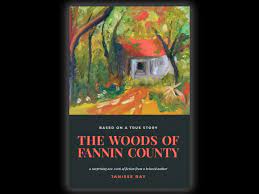 The Woods of Fannin County
The Woods of Fannin County
Fiction by Janisse Ray
July 2022
209pp., $19.99
ISBN: 979-8986306407 (paper)
$19.99 (paperback)
Review by John C. Krieg
There’s something unique about the lifelong inhabitants of America’s south, hard for outsiders to fathom, but undeniably present, and that’s an unwavering loyalty to their own. Georgia born and bred environmentalist and nature writer Janisse Ray exudes this dynamic in all of her literary works leaving little doubt that her roots are sunk deep in that southern soil. Best known for her magically lyrical nonfiction, especially 2000’s Ecology of a Cracker Childhood, which was a winner of The American Book Award, she is refreshing and unpredictable in how she presents her material and expresses herself. Ray is a master of voice, especially one that has the coy simplicity and flavor of a southern twang. There is no one else like her; I know because I have been looking for that someone for over 30 years, and nobody even comes close. Because of her loyalty to her home state, and that unique voice, in 2015 she was inducted into the Georgia Writers Hall of Fame. The south embraces its own.
The Woods of Fannin County is Ray’s first foray into historical fiction, and if history is anything, it’s an in-depth study of human nature. This work explores the dark depravity of uncaring adult self-absorption offset by the innocence and determination of children forced to survive against all odds because of it. In 1945 the Woods family of Morganton, Georgia completely implodes. The father shirks all responsibility and heads north, and the mother flounders in ineptitude and dysfunction. This is not at all good news for the eight children they leave in their destructive wake. The grandparents are left to pick up the slack and in strikingly uncompassionate fashion dispatch of the kids as quickly as possible by taking them to a dilapidated mountain cabin located in the Blue Ridge foothills slightly south of the North Carolina state line. This is the southern tail of Appalachia, a region that has always been defined by rugged terrain, isolation, and extreme poverty.
Anyone coming up the brier-thick trail, had there been anyone, would have been surprised to see a band of children, a perfect stairstep from baby to oldest had they lined up, eight in all. Bobby was the oldest, followed by Glenda, then Phyl, then Richard and Beckie. Jimmy and Bev were still toddlers, and Jeannie was the baby.
The mother, Ruby, stays for a few days and then leaves which becomes an ever widening pattern – gone a few days then back a few days, gone a week, gone a month, gone.
Janisse Ray was told snippets of this incredible story by her late father who then introduced her to Jimmy Woods. Georgian to Georgian they must have struck a chord causing her to pursue the project. In her preface Ray explains what drew her in and caused her to interview five of the eight children over the span of 10 years. By necessity Ray had to improvise her central character, Bobby Woods, in a most unorthodox way. Continuing on in her preface the author explains:
I would like to note that the main character in this novel, Bobby, is an amalgamation of the grown children with whom I spoke. Although the story is told in Bobby’s voice, in reality I never spoke with him, because he died by the time we began the project. Additionally, in the book Bobby accompanies his siblings when they are rescued. In real life, however, Bobby was too old to be accepted to the children’s home and, unbelievably, he was forced to strike out on his own at fourteen. Exactly what happened to him between fourteen and adulthood we will never know.
Bobby Woods was ten when he and his siblings were abandoned and he bore the brunt of the responsibility of protecting and providing for them all. He was a hero to his siblings and the obvious choice for Ray to utilize as the story’s narrator although she could have taken an easier path by selecting one of the living children, but as an author Janisse Ray never takes the easy way out. She slogs through the hard work of crafting a believably noble yet flawed character that doesn’t really experience the typical hero’s journey – just the ongoing stressful grind of everyday, day in and day out survival.
The children forage for food and firewood and when the natural supply ran low they had to resort to occasionally stealing from townspeople and relatives alike. It was a difficult time for all, I know, but it’s hard not to look upon the adults as anything but white trash. What does it say of them that these children were forced to steal food from their own blood relatives?
This is a shockingly gritty account that does not reflect well upon the adults who refused to be held accountable, as Bobby explains:
I’ve thought about this from all angles and that’s what I come back to, every time. I think they needed to get rid of us and they were too proud to give us away, or maybe they didn’t know anybody who would want us, and so they took us up to that mountain to die. They figured the littlest ones would die first. And they almost did (p. 130).
The beauty of historical fiction is that the historical part gives the author easily identifiable landing pads to settle upon because the dates have to line up to truly be history, but the grey areas between the dates become fair game for the author to create bridges that keep the story interesting, and the reader engaged. Ray’s vast knowledge of the flora and fauna of the natural world comes into play here as anyone who has to live off the land quickly learns what is or is not edible. She doesn’t dwell on the inherent hardships and dangers of the children’s mountain existence, but any reader with any degree of imagination can easily envision that these children had to be the living breathing embodiments of the word squalor. They lived in a cabin with no electricity, no running water, no central heating or cooling. There was a massive hole in the central room’s floor, the roof most likely leaked, and the porch was falling in. Food, when it was cooked, had to be boiled or roasted over an open wood fire. All eight of them slept on a cobbled together straw mattress without enough blankets and all were subjected to the baby’s frequent bed wetting. There was no outhouse. Water had to be drawn from a nearby spring. The woods were teeming with bear, panthers, and poisonous snakes. Their clothing became nothing more than rags. Any adult gazing upon them could easily see that they were disheveled, unkempt, and unquestionably dirty, and yet for four years the adults did nothing; and that four year fight to simply stay alive is where Ray concentrates her considerable literary abilities. Bobby states:
That’s why I have to blame an entire community. A lot of people knew we were up there in the woods and those people could have done something. But they didn’t. They didn’t want to get involved. Maybe they didn’t have enough for their own families to eat, so they just shoved us to the back of their thoughts. I know when people like Mrs. Carolina Auberry saw Mama in town, she knew in the front of her mind where Mama’s younguns were, up a mountain in an old shack, freezing to death or starving to death or hankering to death for a kind word or a soft, loving hand.
As bad as things were, unfortunately, they could always get worse, which they did when gritty turns to gruesome concerning Ruby’s frequent and vicious mistreatment of Phyllis who she knew was the local sheriff’s daughter culminating in an ugly event.
Phyl told me years later what happened. I’ll tell it just like it was told to me. I’m warning you, it’s an awful story. Terrible. It’s the worst kind of thing to know about and even worse to experience. But it’s part of the story, like it or not. Phyl was raped by a broomstick. She was tied to the bed. Why? Because Phyl reminded Ruby of Red…All that hatred she felt toward him she took out on Phyl. Also because the baby would stop crying when Phyl picked it up. But it would keep crying when Mama picked it up. The baby thought Phyl was her mama, and Ruby was jealous of that. She told Phyl that she’d make sure she never had young’uns. And she did.
Members of a civilized society may or may not believe that there’s a God in this world, but the vast majority recognize the difference between good and evil, and the necessity for good to prevail, if the concept of civilization is to persist. In that vein, this suffering simply had to come to an end and inevitably, for the sake of a greater good, it did.
People called it “The Home.” For us, it was a home, but not, home. It was not the loving home I craved. In fact I hated the children’s home with a passion. We had a house mother and a father, but not a real mother or a real father .
I’ve seen the paperwork. As a kid I couldn’t have known this, but the paperwork says we were up on the mountain for four years . That’s what they figured. That means the baby was four years old when we got out. I was fourteen. Glenda was almost thirteen. Phyl was ten. And so on.
I still don’t know how we did it. How we lived. How we survived.
In the short view, this is a story about the repulsiveness of unimaginable human adversity. In the long view this is a story of triumph, because when you consider the alternative, survival is the ultimate victory. The Woods children went on to lead productive lives and become contributing members of society. Whatever psychological damage this deplorable experience inflicted upon them, they managed to keep its negative impact under control. While perhaps not a happy ending, at least a satisfying one.
In the end Ray makes a humble request that if the reader finds the story noteworthy that they pass that information on down the line.
Telling friends about meaningful books is still the best way to allow a story to do its job, which is touch us, open our hearts, and make us think.
Message received. This is a book that perfectly balances on the edge of raw emotion and human compassion and it accomplished its goal because it certainly made me feel.
……
 John C. Krieg is a retired landscape architect and land planner who formerly practiced in Arizona, California, and Nevada. He is also retired as an International Society of Arboriculture (ISA) certified arborist and currently holds seven active categories of California state contracting licenses, including the highest category of Class A General Engineering.
John C. Krieg is a retired landscape architect and land planner who formerly practiced in Arizona, California, and Nevada. He is also retired as an International Society of Arboriculture (ISA) certified arborist and currently holds seven active categories of California state contracting licenses, including the highest category of Class A General Engineering.